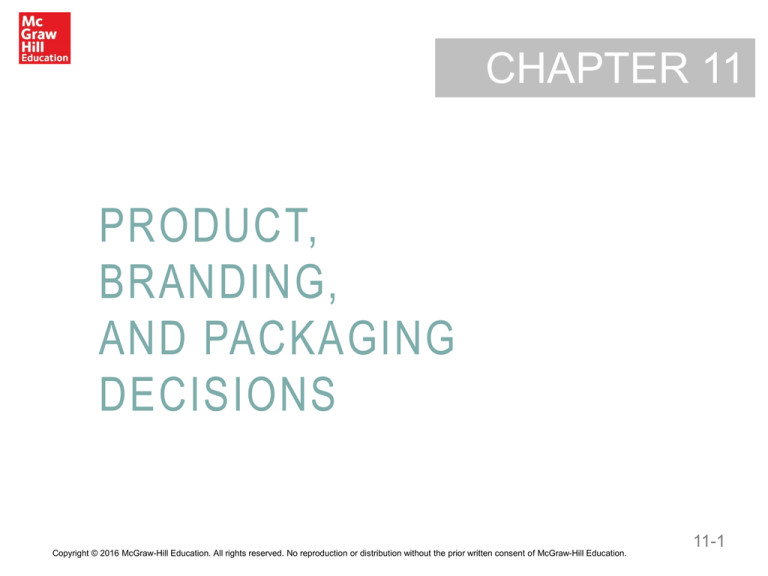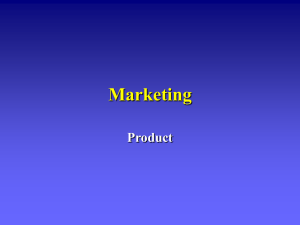
CHAPTER 11
PRODUCT,
BRANDING,
AND PACKAGING
DECISIONS
Copyright © 2016 McGraw-Hill Education. All rights reserved. No reproduction or distribution without the prior written consent of McGraw-Hill Education.
11-1
Product, Branding,
and Packaging Decisions
LEARNING OBJECTIVES
LO1
Describe the components of a product.
LO2
Identify the types of consumer products.
LO3
Explain the difference between a product mix’s breath and
a product line’s depth,
LO4
Identify the advantages that brands provide firms and
consumers.
LO5
Explain the various components of brand equity.
LO6
LO7
LO8
Determine the various types of branding strategies used by
firms.
Distinguish between brand extension and line extension.
Indicate the advantages of a product’s packaging and
labeling strategy.
11-2
Red Bull
Jay Nemeth/ZUMA Press/Newscom
11-3
Complexity of Products
Michael Blann/Digital Vision/Getty Images
11-4
Types of Products
Specialty
Shopping
Convenience
Unsought
11-5
CHECK YOURSELF
1. Explain the three components of a product.
2. What are the four types of consumer products?
11-6
Product Mix and
Product Line Decisions
Abbreviated List of BMW Product Mix
Product Lines
BMW
2 Series
3 Series
4 Series
5 Series
6 Series
7 Series
X Series
Z4 Series
M Series
BMW i
Hybrid
MINI
Clubman
Convertible
Countryman
Coupe
Hardtop
John Cooper Works
Paceman
Roadster
Rolls-Royce
Ghost
Phantom
Wraith
Motorrad
C Series
F Series
G Series
K Series
R Series
S Series
Source: Kellogg’s 2010 annual report, http://annualreport2010.kelloggcompany.com/innovation.htm.
11-7
Product Mix and
Product Line Decisions
Breadth
• Number of product
lines
Depth
• Number of categories
within a product line
Courtesy Pepsi Cola Company
11-8
Change Product Mix Depth
Increase Depth
Band-Aid now has
over 40 products to
heal cuts.
Decrease Depth
McCormick spices
eliminates dozens of
products each year.
©M Hruby
11-9
Change Product Mix Breadth
•
Increase Breadth
–
•
True Religion Brand
Jeans now are a
lifestyle brand with
apparel, belts,
swimwear and
fragrances
Decrease Breadth
–
Due to competitive
changes, TCBY is now
focusing on Yogurt.
©Procter & Gamble
11-10
How is this changing
the product mix?
Does it increase
breadth or depth?
Is this research or
advertising?
CLOROX® is a registered trademark of The Clorox Company Used with permission
Product Line Decisions
11-11
CHECK YOURSELF
1. What is the difference between product line
breadth versus depth?
2. Why change product line breadth?
3. Why change product line depth?
11-12
Branding
A brand can use: Name, logo symbols, characters,
slogans, jingles and even distinctive packages.
http://www.youtube.com/watch?v=aNddW2xmZp8
11-13
McGraw-Hill
Companies, Inc.
What Makes a Brand?
Logos and
symbols
Characters
URLs
Slogans
www.eBay.com
©M. Hruby.
Brand name
Branding
Jingles/Sounds
“Law & Order”
11-14
Value of Branding for the Customer
Facilitate Purchasing
Establish Loyalty
Protect from Competition
Are Assets
Impact Market Value
Apple wins in the
Apple vs Samsung patent lawsuit
11-15
Brand History in Advertising
11-16
Brand Equity: Brand Awareness
Source: Interbrand’s Best Global Brands 2013 report is a look at financial performance of the brand, role of brand in the purchase decision
process, and the brand strength. Go to http://www.bestglobalbrands.com for more information. Reprinted with permission.
11-17
Brand Equity: Perceived Value
How do discount
retailers like Target,
T.J. Maxx, and H&M
create value for
customers?
Photo by Peter Kramer/Getty Images
11-18
Brand Equity: Brand Associations
Vince Talotta/Toronto Star/Getty Images
11-19
Brand Equity: Brand Loyalty
Consumers are often
less sensitive to price
Marketing costs are
much lower
Firm insulated from
the competition
Copyright State Farm Mutual Automobile Insurance
Company 2005 Used by permission
11-20
CHECK YOURSELF
1. How do brands create value for the customer
and the firm?
2. What are the components of brand equity?
11-21
Brand Ownership
Manufacturer brands or
national brands
Private-label brands or
Store Brands
•
•
•
•
Premium
Generic
Copycat
Exclusive co-branded
11-22
Brand Ownership
Private Label
McGraw-Hill Companies
11-23
Brand Ownership
Who Owns the Brand?
Manufacturer/National Brand
Common Name
or Not?
Retailer/Store Brand
Family
Brands
Kellogg’s family line
Kroger’s line
Individual
Brands
Kellogg’s individual brand
Kroger’s individual brand
All photos: ©M. Hruby.
11-24
Naming Brands and Product Lines
Corporate or family brand
The Gap
Corporate and product line brands
Kellogg’s Corn Flakes
Individual lines
Mr. Clean (Proctor & Gamble)
©M. Hruby.
11-25
Brand Extension
©M Hruby
State Farm
11-26
Brand Dilution
Evaluate the fit between
the product class
of the core brand
and the extension.
Evaluate consumer
perceptions of the
attributes of the core brand
and seek out extensions
with similar attributes.
Refrain from
extending the brand
name to too many
products.
Is the brand
extension distanced
enough from the
core brand?
11-27
Co-branding
©M Hruby
Zite
Personalized
Magazine
11-28
Brand Licensing
Photo by D. larke Evans/NBAE via Getty Images.
11-29
Brand Repositioning
How is this
repositioning?
Courtesy The Procter & Gamble Company
11-30
CHECK YOURSELF
1. What are the differences among manufacturer
and private-label brands?
2. What is co-branding?
3. What is the difference between brand
extension and line extension?
4. What is brand repositioning?
11-31
Packaging
What other packaging
do you as a consumer
find useful?
©M. Hruby.
11-32
Product Labeling
C Sherburne/PhotoLink/Getty Images
©The McGraw-Hill Companies, Inc/Elite Images
11-33






